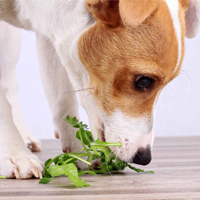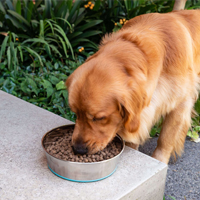
The Truth About Obesity in Dogs
Research tells us that about 40 percent of all dogs are either overweight or obese. Because this generates a variety of health problems, getting in front of this serious issue is important.
But how do dogs become overweight in the first place? And how can it be prevented, especially if you have a dog that simply loves to eat?
In this article, we’ll answer some of these questions and come up with a comprehensive strategy to deal with your dog’s weight control.
What causes dogs to become overweight?
The fact of the matter is that the same causes that create obese or overweight humans are the same causes that create obese or overweight dogs.
- When one’s calorie intake is greater than the amount of calories that are burnt off in a day, surplus calories are converted into fat. So when you feed your dog the prescribed portion of dog food and add other things like table scraps, you boost your dog’s caloric intake.
- Poor dog food choices such as kibble are a huge factor for creating obesity in dogs. Many of these cheap brands contain sugar as a way of enticing dogs to eat the food. Plus, the dog never really gets what he needs nutritionally, so he’s never full and constantly feels hungry.
- Dog treats and other goodies should make up no more than 10 percent of the total diet. Other food intake should be adjusted in accord with how many treats you’re feeding your dog.
- When you throw a lack of activity into the mix, you’ve got the perfect recipe for an overweight or obese dog. Unfortunately many dog owners don’t walk their dog enough and all the unhealthy things we feed them are predictably converted to fat.
- When dogs age, their metabolism slows, bringing down their caloric requirements. We too seldom amend the diets of mature dogs, leading to more problems as they get older.
- Health issues like hypothyroidism can also lead to weight issues, so consult your veterinarian for a complete blood work profile so that you can determine if other problems could lead to obesity in the long run.
Why is obesity a problem in dogs?
Once again, obesity is a problem in dogs for the same basic reasons it’s a problem in human beings.
- The extra weight puts additional strain on the dog’s body, causing joint, bone and muscle stress that can lead to conditions like muscle strains and ligament tears. Joints can deteriorate in overweight dogs and arthritis can develop more rapidly.
- Dogs can also be more subject to orthopedic problems, like hip dysplasia, and back problems are common.
- Overweight dogs are susceptible to having problems with internal organs. The extra weight requires the heart to work harder to pump blood, which can lead to higher blood pressure and serious events like heart attacks. Fat in the chest area can prevent the lungs from expanding, which can lead to breathing trouble.
- Diabetes is a problem seen in more and more obese and overweight dogs. Because extra weight causes an increase in the production of insulin, the overall production of insulin can be exhausted in the long run. And that, just like in human beings, leads to cases of diabetes.
How is obesity in dogs treated?
The first thing to do is to have a complete exam with your holistic veterinarian. Before starting any kind of weight loss program with your dog, you’ll need to rule out any medical causes of obesity. From this standpoint, you can know what you’re treating and get in front of the problem properly. Your veterinarian will help design a dietary program that you can oversee. It’s important to understand that dogs who eat a low grade kibble will continuously eat more because they are not getting what they need nutritionally. Here’s a list of excellent dog food brands.
If the problem is caloric intake, the solution is apparent and yet immeasurably hard to implement in some cases – especially if the dog is used to pleading for table scraps and getting extra indulgences through the day. Reduce caloric intake progressively and bump up your dog’s exercise time, even if it requires reshuffling your timetable.
There are also certain weight loss diets that are available commercially. You can feed your dog smaller meals more often, which can help curb calories while convincing your dog that he or she is not being deprived of any food.
Get everyone on the same page. You don’t need your spouse sneaking your old friend treats on the side, for instance, so ensure that everyone knows that the family friend is trying to lose weight – and stick with it. Don’t send your dog mixed messages by being inconsistent with his or her new diet.
Finally, don’t neglect the exercise component. Don’t start a rigorous exercise program if your dog is more sedentary, but do ensure that you start slow to work him or her into short walks. Bump up the time as you go along and get your dog moving slowly but surely. This will help get his or her body used to the activity at a moderate pace.
Starting an exercise program is easy to do, but keeping it going is the hard part. Make sure that you encourage your dog’s progress with lots of praise and warmth. Cheer him or her on and find ways to reward your pooch without relying on treats. This will let him or her know that losing weight is the right thing to do.
It will benefit the entire household and give you more years with your best friend. What greater incentive is there than that?










